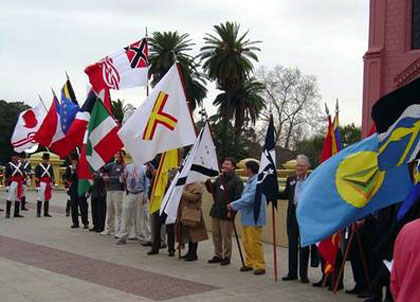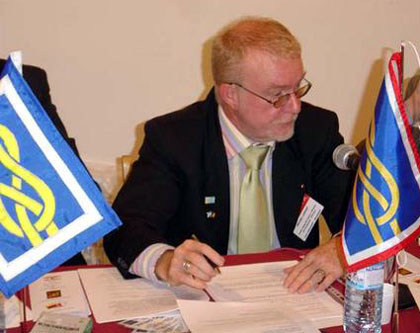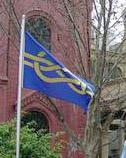|
The International Federation of Vexillological Associations (FIAV) is the umbrella organization of flag-studies associations worldwide. Its 51 members (on six continents) pursue Vexillology-the study of flags of all kinds, their history and their symbolism. There are 49 associations with full membership (voting rights during FIAV General Assemblies) and two associate members.
The members are:
* Asociación Argentina de Vexilología (AAV) (Argentina)
* Asociación Venezolana de Simbología (AVS) (Venezuela)
* Associació Catalana de Vexil·lología (ACV)
(Spain: Catalonia)
* The Burgee Data Archives (BDA) (Canada)
* The Canadian Flag Association (CFA) / L'Association canadienne
de vexillologie (Canada)
* Centre Belgo-Européen d'Études des Drapeaux (CEBED)(Belgium)
* Centro Italiano Studi Vessillologici (CISV) (Italy)
* Centrum Flagi Ziemi (CFZ) / Earth Flag Centre (Poland)
* Ceská Vexilologická spolecnost (CVS) (Czech Republic)
* Chesapeake Bay Flag Association (CBFA) (United States: Delaware,
District of Columbia, Maryland, New Jersey, Pennsylvania, Virginia,
West Virginia)
* Confederate States Vexillological Association (CSVA) (United States:
Alabama, Arizona, Florida, Georgia, Kentucky, Louisiana, Maryland,
Mississippi, Missouri, New Mexico, North Carolina, Oklahoma, South
Carolina, Tennessee, Texas, Virginia, West Virginia)
* Deutsche Gesellschaft für Flaggenkunde e.V.(DGF) (Germany)
* The Flag Design Center (FDC) (Poland)
* Flag Heritage Foundation (FHF) (United States)
* The Flag Institute (FI) (United Kingdom)
* The Flag Research Center (FRC) (United States)
* Flag Research Centre of Sri Lanka (FRCSL) (Sri Lanka)
* Flag Society of Australia Inc. (FSA) (Australia)
* Flags of the World (FOTW) (The World (Internet); HQ actually in
Canada)
* Fundación Centro Interdisciplinario de Estudios Culturales
(CIDEC) (Argentina)
* Great Waters Association of Vexillology (GWAV) (United States:
Illinois, Indiana, Kentucky, Michigan, Ohio)
* Heraldica Slovenica (HS) (Slovenia)
* Heraldischer Verein "Zum Kleeblatt" von 1888 zu Hannover
e.V. (HVK) (Germany)
* The Heraldry and Vexillology Society of Malta (HAVSOM) (Malta)
* Instytut Heraldyczno-Weksylologiczny (IHW) (Poland)
* Kevarzhe Vannielouriezh Vreizh (KVV) / Société Bretonne
de Vexillologie (France: Brittany)
* Magyarországi Záslo Társaság (MZT)
(Hungary)
* Mauritius Buch Verlag GmbH (MBV) (Germany)
* National Flag Foundation (NFF) (United States)
* Nederlandse Vereniging voor Vlaggenkunde (NVvV)(Netherlands)
* New England Vexillological Association (NEVA) (United States:
Connecticut, Maine, Massachusetts, New Hampshire, Rhode Island,
and Vermont)
* New Zealand Flag Association (NZFA) (New Zealand)
* Nihon Kishougaku Kyoukai (JAVA) / Japanese Vexillological Association
(Japan)
* Nordisk Flaggselskap (NF) / Nordisk Flagselskab / Nordiska Flaggsällskapet
/ Norræna Fánafélagið / Pohjoismaiden Lippuseura
/ (Denmark, Finland, Iceland, Norway, Sweden])
* North American Vexillological Association (NAVA) (Canada, United
States)
* Partioheraldikot r.y. (PH) (Finland)
* Polskie Towarzystwo Weksylologizne (PTW) (Poland)
* Российский
Центр флаговедения
и геральдики
(RCVH) / Russian Centre of Vexillology and Heraldry (Russia)
* Schweizerische Gesellschaft für Fahnen- und Flaggenkunde
(SSV) / Société Suisse de Vexillologie / Società
Svizzera di Vessillologia (Switzerland)
* Sociedad Española de Vexilología (SEV) (Spain)
* Societas Vexillologica Belgica (SVB) (Belgium)
* Societatea de Genealogie, Heraldica si Arhivistica "Paul
Gore" (SGHAPG) (Moldova)
* Societatea Românâ de Vexilologie (SRV) (Romania)
* Société française de vexillologie (SFV) (France)
* Southern African Vexillological Association (SAVA) (Angola, Botswana,
Lesotho, Madagascar, Malawi, Mozambique, Namibia, South Africa,
Swaziland, Zambia, Zimbabwe)
* Stredisko Vexilologických Informací (SVI) / Flag
Data Centre (Czech Republic)
* Tumbling Waters Museum of Flags (TWMF) (United States)
* Українське
геральдичне
товариство
(UHT) / The Ukrainian Heraldry Society (Ukraine)
* Västra Sveriges Heraldiska Sällskap (VSHS) (Sweden)
* Vexillological Association of the State of Texas (VAST) (United
States: Texas)
* World Vexillological Research Institute (WVRI) (Germany)

Flag parade of FIAV-members (photo: Francisco Gregoric)
FIAV was founded during the 2nd International Congress of Vexillology in Zurich in 1967 and was officially confirmed during the 3rd International Congress for Vexillology.
The 12 founding members of FIAV were:
- the Swiss 'Schweizerische Gesellschaft für Fahnen- und Flaggenkunde',
- the two Dutch Societies 'Nederlandse Vereniging voor Vlaggenkunde' and 'Stichting voor Banistiek en Heraldiek',
- the flag-group of the British 'Heraldry Society',
- the German 'Wappen-Herold',
- the French 'Association Française des Etudes Internationales de Vexillologie',
- the 'Office Généalogique et Héraldique' from Belgium,
- the flag-group of the Italian 'Accademia di San Marciano' and
- the US-American 'Flag Research Center', 'National Flag Foundation', 'North American Vexillological Association' and the 'United States Flag Foundation'.
FIAV's aim is to promote vexillology as science, to coordinate the activities of its members, to facilitate the exchange of information, and to bring the vexillologists of the different countries closer together. Today FIAV is an international community of over one thousand specialists and friends of flags of all kinds, organized in national or regional organizations.
Since 1965, the vexillologists of the world meet every two years in an international congress, hosted by one of its member associations.
Such congresses usually offer five days of scientific programming, scholarly interaction, and information exchange. Participants appreciate the opportunity to make new acquaintances and to renew old personal contacts. The presentations and discussions during the Congresses are later published in the proceedings, electronically or in printed form.
ICV 1
|
Muiderberg,
Netherlands |
4.-5.
September
1965 |
Stichting voor Banistiek en Heraldik |
ICV 2
|
Zurich-Rüschlikon,
Switzerland |
1.-3.
September
1967 |
Gilde der Züricher Heraldiker/
Schweizerische Gesellschaft für Fahnen- und Flaggenkunde |
ICV 3
|
Boston,
USA |
5.-7.
September
1969 |
The Flag Research Center/ Heraldry
Society of Canada/ North American Vexillological Association/
United States Flag Foundation |
ICV 4
|
Turin,
Italy |
24.-27.
June
1971 |
Accademia di San Marciano, Sezione
Vessillologica |
| ICV 5 |
London,
United Kingdom |
13.-18.
September
1973 |
The Flag Institute |
ICV 6
|
IJsselmeer,
Netherlands |
16.-20.
April
1975 |
Stichting voor Banistiek en Heraldiek |
ICV 7
|
Washington,
USA |
10.-14.
June
1977 |
The Flag Research Center/ North
American Vexillological Association |
ICV 8
|
Vienna,
Austria |
26.-29.
June
1979 |
Gesellschaft für Österreichische
Heereskunde |
ICV 9
|
Ottawa,
Canada |
24.-28.
August
1981 |
The Flag Research Center/ Heraldry
Society of Canada/ North American Vexillological Association |
ICV10
|
Oxford,
United Kingdom |
25.-30.
September
1983 |
The Flag Institute/ Heraldry Society
Flag Section |
ICV11
|
Madrid,
Spain |
26.-31.
May
1985 |
Sociedad Española de Vexillología |
ICV12
|
San Francisco,
USA |
12.-16.
August
1987 |
The Flag Research Center/ North
American Vexillological Association |
ICV13
|
Melbourne,
Australia |
24.-29.
September
1989 |
Flag Society of Australia Inc. |
ICV14
|
Barcelona,
Spain |
30. June -
05. July
1991 |
Associació Catalana de Vexillología |
ICV15
|
Zürich,
Switzerland |
23.-27.
August
1993 |
Schweizerische Gesellschaft für
Fahnen- und Flaggenkunde |
ICV16
|
Warsaw,
Poland |
01.-05.
July
1995 |
Centrum Flagi Ziemi/ The Flag
Design Centre/ Polskie Towarzystwo Weksilogizne |
ICV17
|
Cape Town,
Republic of
South Africa |
10.-16.
August
1997 |
The Southern African Vexillological
Association |
ICV18
|
Victoria,
Canada |
28. July-
02. August
1999 |
The Canadian Flag Association/
North American Vexillological Association |
ICV19
|
York,
United Kingdom |
23.-27.
July
2001 |
The Flag Institute |
ICV20
|
Stockholm,
Sweden |
25.-30.
August
2003 |
Nordisk Flaggselskap |
ICV21
|
Buenos Aires,
Argentinia |
30.July-
06.August
2005 |
Association Argentina de Vexilologia/
Fundacion Centro Interdisciplinaro des Estudios Culturales |
ICV22
|
Berlin,
Germany |
06.-10.
August
2007 |
Deutsche Gesellschaft für Flaggenkunde |
|
|
|
|
|
During every International Congress of Vexillology, the FIAV General Assembly meets and elects the Board, which conducts the affairs of FIAV for the next two years. Members of the Board are the President, the Secretary General, and the Secretary for Congresses. They have to come from different countries and from at least two continents. The General Assembly can admit new members, adopt guidelines, or make changes to the FIAV bylaws. It also determines the venue and the organizer of the next International Congress for Vexillology.
The Secretary General of FIAV is responsible for publishing an annual information bulletin for FIAV members (INFO-FIAV).
| GA 1 |
Boston, USA |
07.09.1969 |
| GA 2 |
Turin, Italy |
24.06.1971 |
| GA 3 |
London, United Kingdom |
14.9. und 17.9.1973 |
| GA 4 |
IJsselmeer, Netherlands |
17.-18.4.1975 |
| GA 5 |
Washington, USA |
12.06.1977 |
| GA 6 |
Vienna, Austria |
29.06.1979 |
| GA 7 |
Ottawa, Canada |
27.-28.8.1981 |
| GA 8 |
Oxford, United Kingdom |
26.9. und 28.-29.9.1983 |
| GA 9 |
Madrid, Spain |
27.-28.5. und 31.5.1985 |
| GA 10 |
San Francisco, USA |
23.-15.8.1987 |
| GA 11 |
Melbourne und Hallarat,
Australia |
25.9. und 27.9.1989 |
| GA 12 |
Barcelona, Spain |
1.-2.7. und 4.7.1991 |
| GA 13 |
Zürich, Switzerland |
23.8,25.8. und 27.8.1993 |
| GA 14 |
Warsaw, Poland |
1.-3.7. und 5.7.1995 |
| GA 15 |
Cape Town,
RSA |
11.-14.8.1997 |
| GA 16 |
Victoria, Canada |
29.-30.7.1999 |
| GA 17 |
York, United Kingdom |
23.7.-24.7.2001 |
| GA 18 |
Stockholm, Sweden |
26..-28.7.2003 |
| GA 19 |
Buenos Aires, Argentinia |
1.-5.8.2005 |
| GA 20 |
Berlin, Germany |
7.-9.8.2007 (planned) |
The Board of the FIAV

Präsident Michel Lupant (photo: Francisco Gregoric)
· President: Michel Lupant, 6, Clos de la Pasture, 1340
Ottignies, Belgium
· General Secretary: Charles A. Spain, Jr., 504 Branard St.,
Houston, TX 77006-5018, USA
· Secretary for Congresses: Graham Bartram, The Flag Institute,
14 Bellview Manor, Ruislip, Middlesex, United Kingdom
The publications of FIAV
The FIAV publishes the information sheet "Info-FIAV" (ISSN 1560-9979),
chronicling the internal affairs of the organization.
All information sheet are published at the homepage: http://www.fiav.org
The flag of FIAV
 The FIAV flag is rectangular in 2:3 proportions. On royal blue field appear two horizontally positioned halyards, reaching from the hoist to the fly, which form in the centre of the flag the "vexillological knot".
The FIAV flag is rectangular in 2:3 proportions. On royal blue field appear two horizontally positioned halyards, reaching from the hoist to the fly, which form in the centre of the flag the "vexillological knot".
The halyards symbolize Vexillology, the science of flags. The blue field of the flag and the two halyards recall navigation, which made flags known all over the world. The knot is symbol of friendship between vexillologists of all nations. The two loops of the knot represent the close ties between the two hemispheres of the world. The two halyards cross the flag from one end to the other--and beyond--thus marking the almost unending field of vexillological research.
The four ends of the halyards and the two loops together make "6", as there are six continents, expressing FIAV's international character.
The flags of most of the international organizations also have a blue field. But in contrast to the light blue (UN blue) used in most cases, the flag of FIAV is royal blue (dark blue). Unfortunately some publications show the FIAV flag with a light shade of blue.
Klaes Sierksma (Netherlands) originated the idea to symbolize FIAV with a knot formed by halyards on its flag. In 1967 a committee of the 2nd International Congress of Vexillology make slight changes to Sierksma's proposal and asked Paul Krog to make the final design.
Sources:
- http://www.atlasgeo.net/ssv/de/fiav.htm; authors: Pascal Gross
- Emil Dreyer
- "FIAV- die internationale Dachorganisation der Vexillologen";
author: Jiří Tenora; in "Der Flaggenkurier" Nr. 1/
1995; page 9

For FIAV matters please contact :
· President: Michel Lupant, 6, Clos de la Pasture,
1340 Ottignies, Belgium
· General Secretary: Charles A. Spain, Jr., 504 Branard
St., Houston, TX 77006-5018, USA
· Secretary for Congresses: Graham Bartram, The Flag
Institute, 14 Bellview Manor, Ruislip, Middlesex, United Kingdom

Contacts
ORGANIZING COMMITTEE OF THE 22.ICV "FLAG-BERLIN
2007"
c/o GERD VEHRES
ANDREASSTRASSE 33
10243 BERLIN , GERMANY
EMAIL: g_vehres@yahoo.de
WEB HOMEPAGE: http://www.flagberlin2007.de
For further information about the German Vexillological
Society:
DEUTSCHE GESELLSCHAFT FÜR FLAGGENKUNDE E.V.
( GERMAN VEXILLOLOGICAL SOCIETY )
POSTFACH (POST BOX) 11 15
28817 ACHIM , GERMANY
WEB HOMEPAGE: http://www.flaggenkunde.de
EMAIL: webmaster@flaggenkunde.de
For further information about the German Historical
Museum:
DEUTSCHES HISTORISCHES MUSEUM
( GERMAN HISTORICAL MUSEUM )
UNTER DEN LINDEN 2
10117 BERLIN , GERMANY
WEB HOMEPAGE: http://www.dhm.de
|




